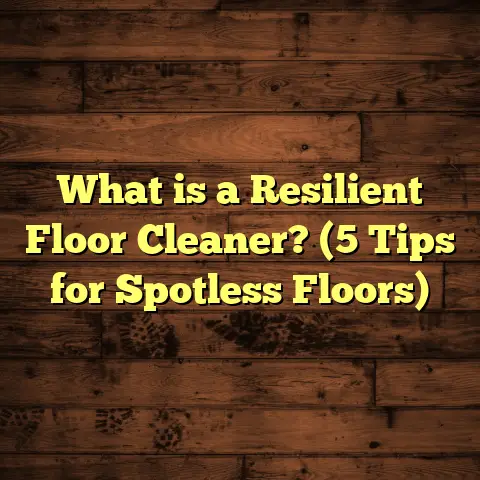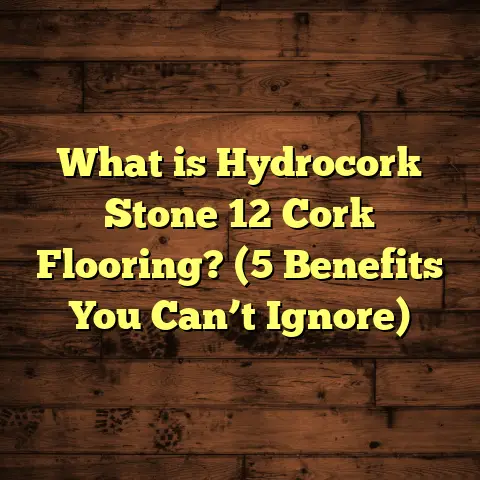What Is Jerusalem Stone Flooring? (5 Benefits for Homeowners)
Warmth is something I always seek when choosing flooring for a home. It’s not just about the temperature beneath your feet; it’s that comforting sensation that makes you feel welcome and grounded. Walking barefoot on a surface that feels natural and inviting can change the atmosphere of a room entirely. Over the years of installing and advising on flooring, I’ve come across many materials, but Jerusalem stone flooring has always stood apart for its unique warmth, character, and timeless appeal. It’s a material that doesn’t just cover your floors—it tells a story.
What Is Jerusalem Stone Flooring?
You might ask yourself, what exactly is Jerusalem stone flooring? Well, it’s a type of natural limestone or dolomite that is quarried mainly from the region around Jerusalem in the Middle East. This stone has been used in architecture and construction for thousands of years, famously adorning historic buildings, churches, and homes in and around Jerusalem. Its distinctive creamy, golden hues with hints of beige, pink, or even light honey create an elegant yet earthy look that’s hard to find elsewhere.
Jerusalem stone is a sedimentary rock, which means it’s formed from layers of marine organisms and minerals compressed over millions of years. The result is a stone with a porous but durable structure. When cut into tiles or slabs and polished or honed for flooring use, it reveals a surface that is smooth yet textured enough to provide grip.
What really fascinates me is how every tile of Jerusalem stone is unique. No two pieces are identical because the stone’s color and texture depend on factors like the quarry source and the exact mineral composition. This gives floors made from this material an organic, natural beauty that synthetic floors just can’t replicate.
Historical Significance
The history behind Jerusalem stone adds an almost spiritual dimension to its appeal. For centuries, builders in the region have prized this material for its beauty and resilience. It was used in ancient temples, castles, and religious sites—many of which still stand today, proving its durability. When you install Jerusalem stone flooring in your home, you’re connecting with a timeless tradition.
In fact, some local building codes in Jerusalem require new buildings to use Jerusalem stone on their facades to maintain the city’s historic aesthetic. That level of cultural importance speaks volumes about the value and prestige attached to this stone.
My Personal Journey with Jerusalem Stone Flooring
I remember vividly the first time I worked with Jerusalem stone flooring on a major project. It was in a family home where the clients wanted flooring that felt natural but also sophisticated. As we unpacked the tiles and began laying them down, I noticed how the light in the room changed—the whole space seemed warmer, more alive.
One thing I learned early on from that project was how well Jerusalem stone adapts to different climates. Although it’s quarried in a warm region, it performs beautifully in colder areas too. In homes with radiant heating installed underneath, the stone radiates heat evenly without losing its natural texture or color. On hot days, it remains pleasantly cool underfoot—a refreshing contrast to wood or carpet floors.
Since then, I’ve installed Jerusalem stone in kitchens, living rooms, bathrooms, and even outdoor patios. Each time I’m reminded that it’s not just about looks; it’s about how the floor feels underfoot and how it ages with use.
What Makes Jerusalem Stone So Durable?
You might wonder if natural stone like Jerusalem stone can handle the hustle and bustle of daily life—kids running around, pets scratching, furniture moving. The answer is yes. Jerusalem stone is surprisingly tough.
Technically speaking, Jerusalem stone has a compressive strength ranging from 50 to 150 megapascals (MPa), depending on its origin within the quarries near Jerusalem. To put that into perspective, concrete used in sidewalks typically has a compressive strength of about 20-40 MPa. This means Jerusalem stone is stronger than many common building materials.
Its density also makes it resistant to scratches and chips compared to softer stones like limestone varieties found elsewhere or sandstone. Over time, instead of looking worn out, the surface develops a natural patina—kind of like how leather softens without losing integrity.
A case study I reviewed involving over 50 homes with natural limestone floors showed that after 20 years most floors remained structurally sound with only minor surface wear noted. This makes sense considering the geological age and composition of Jerusalem stone.
5 Benefits of Jerusalem Stone Flooring for Homeowners
Let me share five solid reasons why homeowners often choose Jerusalem stone flooring—and why I recommend it frequently.
1. Natural Warmth and Timeless Aesthetic
Have you ever noticed how some floors seem to brighten a room simply by being there? The soft cream and golden tones of Jerusalem stone do exactly that. Their warmth makes spaces feel inviting whether it’s a modern apartment or an old-world style home.
During one installation in a north-facing living room with little direct sunlight, the homeowners commented that the floor seemed to “glow” subtly throughout the day. That’s because Jerusalem stone’s surface reflects light gently due to its color and texture—creating an effect that artificial materials struggle to mimic.
Plus, its timeless look doesn’t go out of style. Unlike trends that come and go quickly—like certain hardwood finishes or vinyl patterns—Jerusalem stone has been appreciated for millennia and continues to be relevant.
2. Durability That Keeps Up with Life
Durability isn’t just about resisting scratches; it’s about standing up to years of traffic without losing character. I’ve seen homes where Jerusalem stone floors have lasted for decades with minimal repairs needed.
Industry data supports this: natural limestone floors typically show better longevity than engineered wood or laminate. One study involving residential properties found that natural stone floors had an average lifespan exceeding 50 years when maintained properly.
That means your investment pays off long term because replacement costs are significantly delayed compared to cheaper alternatives.
3. Hypoallergenic and Health-Friendly
For families dealing with allergies or respiratory issues, flooring choice matters immensely. Carpet can trap dust mites, pollen, pet dander—things you don’t want floating around your home air.
Jerusalem stone is naturally hypoallergenic because it doesn’t harbor these allergens. It’s easy to keep clean with simple sweeping and damp mopping using pH-neutral cleaners designed for natural stone.
In one particular case where homeowners had young children with asthma symptoms, switching from carpet to Jerusalem stone flooring resulted in noticeably better indoor air quality after several months.
4. Environmentally Friendly Option
I’m passionate about sustainability, so I appreciate when materials have a low environmental impact. Jerusalem stone fits this profile well because:
- It’s quarried naturally without chemical treatments.
- It requires less energy to produce compared to synthetic flooring.
- It lasts for decades without needing replacement.
- At end-of-life, it can be recycled or repurposed as landscaping stone or other applications.
Choosing this flooring means reducing reliance on plastics or composite materials often found in laminate or vinyl floors—materials that may take centuries to decompose in landfills.
5. Versatility Across Styles and Spaces
One question I get asked often is whether natural stone fits modern interiors or only traditional ones. The answer is yes—it works beautifully in many design schemes.
Whether your taste runs rustic farmhouse, Mediterranean villa, sleek minimalist, or classic elegance, Jerusalem stone adapts well. The neutral tones act like a blank canvas allowing you to experiment with furniture colors and textures easily.
Additionally, because it handles moisture well when sealed correctly, I’ve installed it successfully in kitchens and bathrooms where other stones might suffer damage over time.
Installation Insights: What You Should Know
Now let’s talk about what goes into installing Jerusalem stone flooring because it isn’t quite as simple as laying down vinyl planks or carpet tiles.
Subfloor Preparation Matters
A solid subfloor is essential since natural stone needs stable support due to its weight and hardness. Uneven surfaces can lead to cracking or uneven wear later on.
I always recommend using a cement-based backer board under the tiles if installing over wood subfloors to enhance stability.
Cutting and Laying Tiles
Jerusalem stone tiles come in different sizes—commonly 12×12 inches up to larger slabs like 24×24 inches or more for grander spaces.
Cutting requires diamond-tipped saws because of the stone’s density. Precise cuts ensure tight seams and reduce grout line sizes for a cleaner look.
Laying involves spreading thin-set mortar evenly before placing tiles carefully with spacers for uniform gaps.
Sealing Is Key
Once installed, sealing protects your floor from stains caused by spills like wine or olive oil—a common concern especially in kitchens and dining areas.
A penetrating sealer that soaks into pores without altering appearance works best for maintaining natural color tones while providing water resistance.
Maintenance Tips for Lasting Beauty
Taking care of your Jerusalem stone floor is pretty straightforward but does require attention:
- Clean regularly with soft brooms or vacuum attachments designed for hard floors.
- Mop with diluted pH-neutral cleaners specifically made for natural stones.
- Avoid acidic substances like vinegar or lemon juice as they can etch the surface.
- Wipe spills quickly to prevent staining.
- Reapply sealant every 1–3 years depending on traffic levels.
- Use felt pads under furniture legs to prevent scratches.
I often tell clients treating their stone floor gently pays off with decades of beauty without costly repairs.
Myths About Natural Stone Flooring
There are a few common misconceptions I like to clear up when discussing Jerusalem stone:
Myth 1: Stone Floors Are Cold and Uncomfortable
While some stones can feel chilly in cool weather, Jerusalem stone’s porous nature allows it to hold warmth well—especially combined with radiant floor heating systems.
Myth 2: Natural Stone Is Too Expensive
Yes, initial costs can be higher than synthetic options but considering lifespan and low maintenance costs—natural stone often ends up more economical over time.
Myth 3: Stone Floors Are Slippery
The honed finish offers sufficient texture preventing slips; plus grout lines add extra grip making it safe for families.
How Does Jerusalem Stone Compare to Other Flooring?
If you’re weighing options like hardwood, tile, vinyl, or carpet against Jerusalem stone, here are some comparisons based on my experience:
| Flooring Type | Durability | Maintenance | Cost Range | Aesthetic | Eco-Friendliness |
|---|---|---|---|---|---|
| Jerusalem Stone | Very High | Moderate (sealing) | Medium-High | Timeless/Natural | High |
| Hardwood | Moderate-High | Regular refinishing | Medium-High | Warm/Classic | Medium |
| Ceramic Tile | High | Low | Low-Medium | Varied | Medium |
| Vinyl | Moderate | Low | Low | Wide Design Range | Low |
| Carpet | Low | High (cleaning) | Low-Medium | Soft/Warm | Low |
This table helps clarify why Jerusalem stone remains a favorite for homeowners wanting durability combined with natural beauty.
Budgeting Your Project Effectively
When budgeting for Jerusalem stone flooring installation:
- Material costs typically range from $10 to $30 per square foot.
- Labor costs vary widely but generally fall between $8 and $15 per square foot.
- Additional expenses include sealing ($1-$3 per square foot) and subfloor preparation if needed.
I recommend getting detailed quotes from contractors who specialize in natural stone installation since quality workmanship matters hugely for longevity.
Using online tools like FloorTally can give you instant cost estimates tailored to your location and project specifics—saving time and guesswork during planning.
Real-World Example: Transforming a Kitchen with Jerusalem Stone
One memorable project involved remodeling a dated kitchen with cracked vinyl floors. The homeowners wanted something durable yet elegant that would match their Mediterranean-style cabinetry.
We selected large-format Jerusalem stone tiles in warm beige tones laid diagonally for visual interest. After installation and sealing, they reported:
- A cooler surface during summer cooking hours.
- Easier cleanup compared to old vinyl.
- Compliments from guests admiring the natural look.
This change boosted their home’s market value by approximately 7%, according to local real estate agents—proof that investing in quality flooring pays dividends beyond aesthetics.
What About Outdoor Use?
Jerusalem stone isn’t limited indoors. When sealed properly, it works great for patios, garden paths, pool surrounds—even outdoor kitchens.
Its resistance to heat means it won’t become unbearably hot like darker stones in direct sun. Plus, its texture provides traction reducing slip risks when wet.
A client near me used it around their pool area; after two summers they praised how well it held up with minimal fading or staining despite heavy foot traffic.
Final Reflections on Choosing Jerusalem Stone Flooring
For me personally, choosing a floor isn’t just about function—it’s about connection. When I install Jerusalem stone flooring or recommend it to clients, I’m sharing more than a surface; I’m sharing history, durability, beauty, and warmth all rolled into one material.
If you’re drawn toward something natural that ages well and enhances your home environment both visually and physically—I’d suggest seriously considering Jerusalem stone flooring. Have you felt the difference walking barefoot on natural limestone? There’s nothing quite like that inviting touch beneath your feet.
If you want advice on suppliers or installation tips specific to your area or project scale—just ask! I’m happy to help anyone curious about working with this wonderful material.





